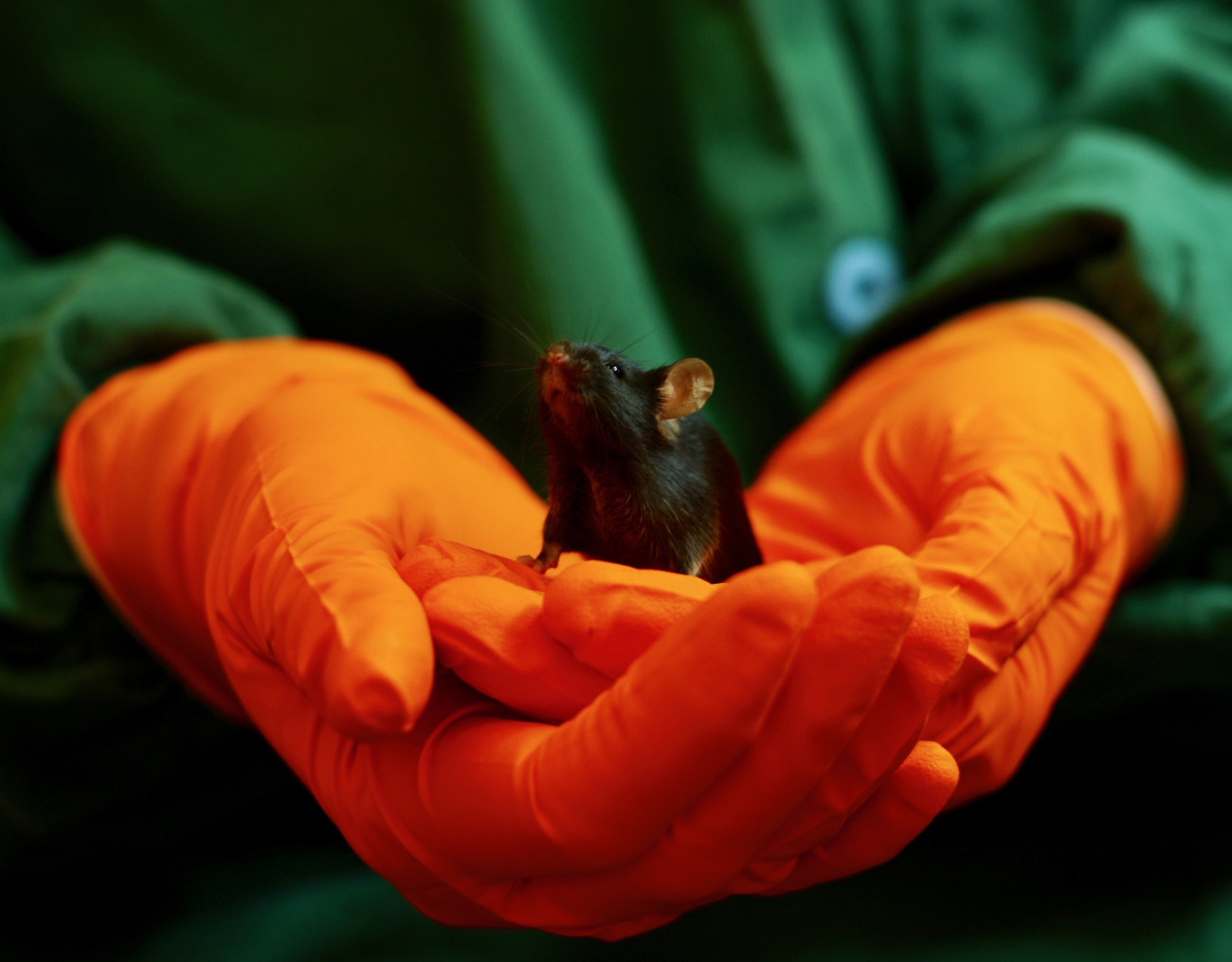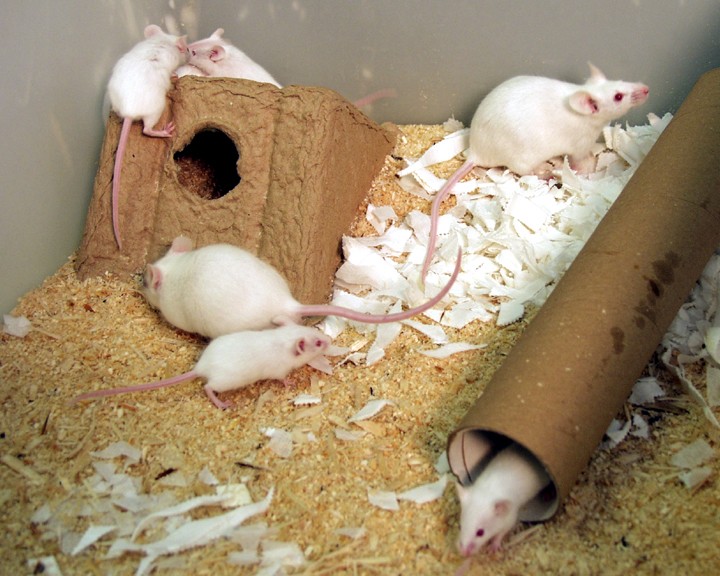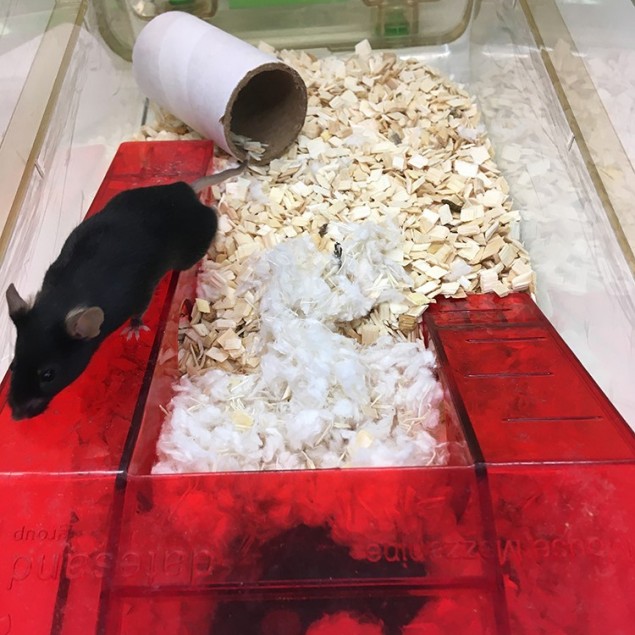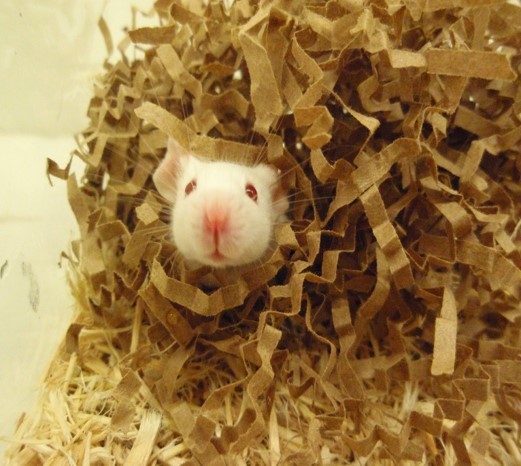Housing and husbandry: Mouse
Information to help refine the housing and husbandry of the laboratory mouse.
On this page
Behaviour

Laboratory mice are derived from the wild mouse Mus musculus. Although they are partially adapted to captive life, laboratory mice perform similar behaviours and have similar behavioural needs to their wild counterparts. Different strains of laboratory mouse can show considerable differences in the expression and intensity of their behaviours [1,2].
Mice are most active during dawn and dusk and may retreat to shelters and nests during the daytime. During their active hours, mice spend their time eating in short and frequent bouts, grooming, gnawing, exploring, climbing, building nests and digging [3]. Laboratory mice may also perform abnormal behaviours known as sterotypies. These repetitive and apparently functionless behaviours can indicate that the welfare needs of the animal are not being met, but this may be strain dependent [4].
Mice are prey species and this should inform how humans interact with them during general husbandry and procedures. Mice respond best to gentle habituation and being picked up using refined methods (i.e. not by the tail). Mice accustomed to being picked up using refined methods (e.g. a tunnel or cupped hands) are less stressed and more cooperative than mice that are picked up the tail, even following restraint and procedures (see the mouse handling research papers table for examples from the literature). Recent advances in technology have led to the development of automated systems that can continually monitor animals with minimal human disturbance. These tools refine studies by minimising the stress associated with being handled and moved from the home cage.
Mice communicate using ultrasonic vocalisations (USVs) [5], scent [6,7], body language and physical contact. Disrupting their ability to communicate can impact social behaviour. For example, cage cleaning removes scent cues and can disrupt the social hierarchy, leading to increased levels of aggression [8, 9].
Additional resources and references
- The 3Hs Initiative, Resource page on the housing, handling and habituation of laboratory mice and rats
- NC3Rs, Mouse handling resources
- NC3Rs Webinar with Research Institutes of Sweden, Handling and training of mice and rats for low stress procedures
- NC3Rs, Automated monitoring of animal behaviour
- Stanford University, Videos of mouse behaviours
- Crawley N et al. (1997). Behavioral phenotypes of inbred mouse strains: implications and recommendations for molecular studies. Psychopharmacology 132: 107-124. doi: 10.1007/s002130050327
- Sultana R. et al. (2019). Contrasting characteristic behaviours among common laboratory mouse strains. R. Soc. open sci. 6: 190574. doi: 10.1098/rsos.190574
- Suckow A et al. (2023). The laboratory mouse. CRC press
- Novak J et al. (2016). Effect of cage-induced stereotypies on measures of affective state and recurrent perseveration in CD-1 and C57BL/6 mice. PLoS One 11(5): e0153203. doi: 10.1371/journal.pone.0153203
- Portfors CV (2007). Types and functions of ultrasonic vocalizations in laboratory rats and mice. Journal of the American Association for Laboratory Animal Science 46(1): 28-34. PMID: 17203913
- Gerdin A et al. (2012). Experimental and husbandry procedures as potential modifiers of the results of phenotyping tests. Physiology and Behavior 106(5): 602-11. doi: 10.1016/j.physbeh.2012.03.026
- Burn CC et al. (2006) Long-term effects of cage-cleaning frequency and bedding type on laboratory rat health, welfare, and handleability: a cross-laboratory study. Laboratory Animals 40(4): 353-70. doi: 10.1258/002367706778476460
- Hurst JL (1993). The priming effects of urine substrate marks on interactions between male house mice, Mus musculus domesticus Schwarz and Schwarz. Animal Behaviour 45(1): 55-81. doi: 10.1006/anbe.1993.1007
- Van Loo PLP et al. (2000). Modulation of aggression in male mice: influence of cage cleaning regime and scent marks. Animal Welfare 9(3): 281-295. doi: 10.1016/S0031-9384(01)00425-5
Social environment

Free-living mice
The free-living mice from which laboratory mice are derived typically live in groups with a single dominant male, several females and their offspring and subordinate males [1]. Free-living animals can manage their social interactions and demonstrate social flexibility in ways that can be impaired or impossible when they are captively housed.
Social housing for laboratory mice
Social housing can facilitate the behavioural needs of mice within the research environment and can provide benefits including social enrichment and social buffering [1,2,3]. Housing mice in family groups to imitate their wild counterparts is not always feasible within a research setting. Instead, housing mice in same sex groups is a common approach.
Within the research environment, mice are exposed to husbandry conditions that can disrupt social stability (e.g. removal of cage mates for experimental use and the removal of familiar odours through frequent cage cleaning). Cage size can also limit the ability of subordinate animals to escape from aggressors. In general, it is advised to keep adult mice in stable groups and avoid constantly removing and introducing new individuals as this could destabilise the established social hierarchy [4,5].
It is advised that when mice are weaned they are housed with familiar littermates. However, when this is not feasible, for example when weaning transgenic strains and only one mouse in a litter has the desired genotype, the ‘companion mouse’ strategy can be used. This strategy involves keeping a ‘companion’ littermate that does not carry the gene of interest in order to avoid the need for single housing.
Single housed male mice
Male mice can be particularly territorial and aggression between group housed males can present a serious welfare concern within the laboratory environment. Steps should be taken to minimise aggression between group housed male mice and this may include single housing of males.
There is some evidence to suggest that male mice may prefer living alone and housing male mice individually is preferential to disharmonious group housing where aggression is constant, severe and cannot be resolved. However, balancing the welfare needs of male mice in respect to social or single housing is context dependent and should be considered on a case by case basis [6]. If mice are single housed it is essential that they are provided with additional nesting material and/or another heat source to allow them to maintain their body temperature.
Pup survival
The social environment is important for pup survival and wellbeing. The presence of two litters in a single cage with a large age difference between them has been identified as a contributing factor to high pup mortality [7]. Therefore, care should be taken to avoid housing two or more litters of different ages together, potentially by removing and temporarily single housing the pregnant females prior to parturition or opting to set up breeding pairs instead of breeding trios.
Additional resources and references
- The 3Hs Initiative, Resource page on the housing, handling and habituation of laboratory mice and rats
- NC3Rs, Minimising-aggression-group-housed-male-mice
- van Loo PLP, Baumans V (2015). Mice. In: Comfortable Quarters for Laboratory Animals. (Eds. Liss C, Litwak K, Tilford D, Reinhardt V), Animal Welfare Institute.
- van Loo PLP and Baumans V (2015). Mice. In: Comfortable Quarters for Laboratory Animals (Eds. Liss C, Litwak K, Tilford D, Reinhardt V), Animal Welfare Institute.
- Hennessy MB et al. (2009). Social buffering of the stress response: Diversity, mechanisms, and functions. Frontiers in Neuroendocrinology 30(4): 470-482. doi: 10.1016/j.yfrne.2009.06.001
- Pham TM et al. (2010). Housing environment influences the need for pain relief during post-operative recovery in mice. Physiology and Behaviour 99(5): 663-8. doi: 10.1016/j.physbeh.2010.01.038
- Lidster K et al. (2019). Cage aggression in group-housed laboratory male mice: an international data crowdsourcing project. Scientific Reports 9(1): 15211. doi: 10.1038/s41598-019-51674-z
- Gaskill BN et al. (2019). The effect of early life experience, environment, and genetic factors on spontaneous home-cage aggression-related wounding in male C57BL/6 mice. Lab Animal 46(4): 176-184. doi: 10.1038/laban.1225
- Kappel S et al. (2017). To group or not to group? Good practice for housing male laboratory mice. Animals 7(12). pii: E88. doi: 10.3390/ani7120088
- Brajona S et al. (2019). Social environment as a cause of litter loss in laboratory mouse: A behavioural study. Applied Animal Behaviour Science 218: 104827. doi: 10.1016/j.applanim.2019.06.008
Living space

The minimum space allocations for laboratory mice in the UK are given in tables 2-2-1 to 2-2-4 of the Code of Practice for the Housing and Care of Animals Bred, Supplied or Used for Scientific Purposes. The minimum legal requirements will vary depending on location. The aim should always be to exceed the minimum and provide sufficient space and environmental complexity to meet the welfare needs of animals.
Mice should be able compartmentalise their space. For example, water and food should be provided in one end of the cage leaving the other end free to be used for urination and defecation [1].
The space within the cage should be maximised to enhance environmental complexity and increase the usable space, for example, by making use of vertical space. Climbing is an important locomotor activity in mice, which can be facilitated by incorporating a grid section in the cage lid. Grid space is limited to the food hopper in Individually Ventilated Cages (IVCs), however additional climbing devices, such as mouse lofts and mezzanines can be provided.
Mice prefer solid floors with suitable bedding, such as wood shavings [2]. Use of grid or wire mesh floors should be avoided as this can lead to injuries. If grids or wire mesh floors are used due to scientific purposes, a solid or bedded area should be provided for the animals to rest on unless specific experimental conditions prevent.
Additional resources and references
-
Home Office (2004). Mice, rats, gerbils, hamsters and guinea pigs. In: Code of Practice for the Housing and Care of Animals Bred, Supplied or Used for Scientific Purposes. Her Majesty’s Stationery Office.
- The 3Hs Initiative, Resource page on the housing, handling and habituation of laboratory mice and rats
- van Loo PLP, Baumans V (2015). Mice. In: Comfortable Quarters for Laboratory Animals. (Eds. Liss C, Litwak K, Tilford D, Reinhardt V), Animal Welfare Institute
- Makowska J et al. (2019). Standard laboratory housing for mice restricts their ability to segregate space into clean and dirty areas. Scientific Reports 9(1): 6179. doi: 10.1038/s41598-019-42512-3
- Jackson E et al. (2015). Aspen shaving versus chip bedding: effects on breeding and behavior. Laboratory Animals 49(1): 46-56. doi: 10.1177/0023677214553320
Environmental enrichment

Environmental enrichment provides sensory and motor stimulation for captive animals and allows them a greater choice of activity and some control over their environment [1,2]. Bedding and nesting material, refuges, and gnawing sticks are the most commonly used enrichment resources for mice and should be provided in every mouse cage unless there is sound scientific justification not to.
Giving mice the opportunity to perform species-typical behaviours, such as nest building or foraging, can significantly improve their lives in the laboratory. Gnawing is also an important behaviour for mouse welfare; as their teeth grow continually through their lives, an inability to gnaw can lead to malocclusion (overgrowth of incisors) and consequently malnourishment. Barren enclosures are associated with signs of impaired welfare, such as anxiety and abnormal repetitive behaviour [1]. During breeding, lack of enrichment has been shown to result in higher pup mortality, reduced pup weight, and delayed development [3].
Mice prefer nesting material over every other form of enrichment [4], including prefabricated refuges, manipulanda and social contact [5]. Nest building is well preserved from wild‐type progenitor mice and is undertaken equally by female and male mice. Assessing the quality of the nest is a great cage-side tool to identify health and well-being issues (such as thermal stress, aggressiveness, sickness, and pain) and nest scoring protocols are available in the literature [6-9]. Even mice at the preclinical stage of a disease (i.e. not yet showing any clear clinical symptoms) may fail to build adequate nests, if they manage to build a nest at all [6,7].
Common nesting materials for laboratory mice include facial tissue, shredded paper strips, compressed cotton squares (nestlets), wood wool, and wood shavings [10,11]. Mice seem to prefer paper-derived materials (e.g. shredded paper) over wood-derived materials (e.g. cotton squares), however, preference for a particular nesting material might depend on the structure rather than the nature (paper or wood) which determines how easily they can manipulated to create a nest [12]. Providing appropriate nesting material can allow even “nest-building challenged” strains (e.g. C3H mice) to build nests comparable to stains with strong building skills (e.g. BALB/c) [13]. Additionally, care should be taken when choosing nesting material for some groups of mice, such as breeding mice or post-surgery mice, as some types of nesting material might have a negative effect on animal welfare [11]. For example, pups and adult mice could get entangled and injured in cotton wool [14,15], and mice with head implants risk getting tangled while trying to build a nest using facial tissue [16].
Mice show preferences for different bedding materials, shelters and gnawing resources, which can be sex or strain specific [17-19]. Therefore, provision of environmental enrichment shouldn’t be a random process whereby different objects are included in a mouse cage based merely upon their availability, instead care should be taken to assess the true beneficial effect on the animals’ overall well-being.
Additional resources and references
- The 3Hs Initiative, Resource page on the housing, handling and habituation of laboratory mice and rats
- NC3Rs, Evaluating Environmental Enrichment Resource page to support technicians in assessing the welfare impact of enrichment
- NC3Rs, Information and resources on malocclusion in mice to improve welfare within a research setting
- Bailoo JD et al. (2018). Effects of cage enrichment on behavior, welfare and outcome variability in female mice. Frontiers in Behavioural Neuroscience 12: 232. doi: 10.3389/fnbeh.2018.00232
- Baumans V (2005). Environmental enrichment for laboratory rodents and rabbits: requirements of rodents, rabbits, and research. Institute of Laboratory Animal Research Journal 46(2): 162-70. doi: 10.1093/ilar.46.2.162
- Leidinger CS et al. (2019). Environmental enrichment prevents pup mortality in laboratory mice. Laboratory Animals 53(1): 53-62. doi: 10.1177/0023677218777536
- Olsson IA and Dahlborn K (2002). Improving housing conditions for laboratory mice: a review of ‘environmental enrichment’. Laboratory animals 36(3): 243-70. doi: 10.1258/002367702320162379
- Hutchinson E et al. (2005). Environmental enrichment for laboratory rodents. Institute of Laboratory Animal Research Journal 46(2): 148-61. doi: 10.1093/ilar.46.2.162
- Deacon R (2012). Assessing burrowing, nest construction, and hoarding in mice. Journal of Visualized Experiments (59): e2607. doi: 10.3791/2607
- Gaskill BN et al. (2013). Nest building as an indicator of health and welfare in laboratory mice. Journal of Visualized Experiments (82): 51012. doi: 10.3791/51012
- Jirkof P (2010). Burrowing Behavior as an Indicator of Post-Laparotomy Pain in Mice. Frontiers in Behavioural Neuroscience 4: 165. doi: 10.3389/fnbeh.2010.00165
- Hess SE et al. (2008). Home improvement: C57BL/6J mice given more naturalistic nesting materials build better nests. Journal of the American Association for Laboratory Animal Science 47(6): 25-31. PMCID: PMC2687128
- Bayne K (2018). Environmental enrichment and mouse models: Current perspectives. Animal Models and Experimental Medicine 1(2): 82-90. doi: 10.1002/ame2.12015
- Van de Weerd HA et al. (1997). Preferences for nesting material as environmental enrichment for laboratory mice. Laboratory Animals 31(2): 133-43. doi: 10.1258/002367797780600152
- Robinson-Junker A et al. (2017). Sorting it out: bedding particle size and nesting material processing method affect nest complexity. Laboratory Animals 51(2): 170-180. doi: 10.1177/0023677216652384
- Rowson KE and Michaels L (1980). Injury to young mice caused by cottonwool used as nesting material. Laboratory Animals 14(3): 187. doi: 10.1258/002367780780937562
- Northrup E et al. (2012). Mice may become caught in nesting material. Lab Animal 41: 147. doi: 10.1038/laban0612-147
- Windsor Z and Bate ST (2019). Assessing the safety and suitability of nesting material for singly housed mice with surgically fitted head plates. Heliyon 5(7): e02097. doi: 10.1016/j.heliyon.2019.e02097
- Kirchner J et al. (2012). Preferences of group-housed female mice regarding structure of softwood bedding. Laboratory Animals 46(2): 95-100. doi: 10.1258/la.2011.010173
- Lopez Juaristi I (2019). A comparison of enrichment items for the promotion of natural gnawing behaviour in laboratory mice. Animal Technology and Welfare 18(2): 93-97.
- Van Loo PL et al. (2005). Assessment of the use of two commercially available environmental enrichments by laboratory mice by preference testing. Laboratory Animals 39(1): 58-67. doi: 10.1258/0023677052886501
Environmental conditions
In addition to the citations given within the text, the following guidance on environmental conditions is based on the UK Home Office Code of Practice for the Housing and Care of Animals Bred, Supplied or Used for Scientific Purposes.
Lights and sounds
Mouse rooms typically have a 12-hour light-dark cycle. It is recommended that light levels within the enclosure are low, particularly for albino animals as they are more susceptible to light-induced retinal damage [1]. Racks should ideally have shaded tops in order to keep light intensity to a minimum and reduce the risk of retinal degeneration.
Mice are sensitive to ultrasound, which they use for communication. Sources of ultrasound in laboratories include dripping taps, trolley wheels and computer monitors, which may affect mouse behaviour and breeding cycles [2,3]. As some sources of ultrasound cannot be eliminated (e.g. laboratory equipment) playing background music may help mask stressful sounds [4]. It is advisable to minimise sudden irregular noises as they create more disturbance in breeding rodents than continuous or predictable sounds and can increase the risk of mis-mothering or cannibalism.
It is possible to make recordings and take measurements of the audible and ultrasonic noise within an animal facility [5,6]. Knowledge about the acoustic environment of animal facilities can be used to minimise disruption to animal welfare and the impacts on scientific outcomes.
Temperature
According to UK Home Office guidelines, the room temperature for mice should be 20–24°C (68–75°F) and kept as stable as possible. However, the thermoneutral zone of mice is between 26°C and 34°C (79–93°F) and therefore they may experience cold stress in the laboratory unless nesting material is provided for them to regulate their body temperature and the microclimate within the cage [7,8]. Sufficient nesting material should be provided that enables them to create good nests, which can reach temperatures of 30–32°C (86–90°F) [8,9]. This is particularly crucial for new born pups which lack the ability to thermoregulate and therefore their survival depends on the warmth of their mother and siblings, which is retained by the nesting material [10].
Ventilation and humidity
The air in the mouse room should be renewed at frequent intervals. Typically, a ventilation rate of five to 20 air changes per hour is adequate for a fully stocked room of mice. The relative humidity should be kept at 45 to 65%.
For IVCs, the number of air changes per hour typically ranges between 25 and 120. As air is blown into the cage at relatively high speed, the intra-cage ventilation rate could lead to chronic stress as well as heat loss due to the draught [8]. Therefore, mice in IVCs should be monitored for any signs of anxiety or discomfort, and the air change rate should be adjusted accordingly. Signs that the mice are reacting to the high air flow include change of location of the nest or building protective barriers against the draught using bedding material [9]. If such changes in behaviour are detected care should be taken to decrease the intra-cage draughts and provide mice a comfortable environment to live in.
Additional resources and references
-
Home Office (2017). Mice, rats, gerbils, hamsters and guinea pigs. In: Code of Practice for the Housing and Care of Animals Bred, Supplied or Used for Scientific Purposes. Her Majesty’s Stationery Office.
- The 3Hs Initiative, Resource page on the housing, handling and habituation of laboratory mice and rats
- van Loo PLP, Baumans V (2015). Mice. In: Comfortable Quarters for Laboratory Animals. (Eds. Liss C, Litwak K, Tilford D, Reinhardt V), Animal Welfare Institute
- Peirson SN et al. (2018). Light and the laboratory mouse. Journal of Neuroscience Methods 300: 26-36. doi: 10.1016/j.jneumeth.2017.04.007
- Hennessy MB et al. (2009). Social buffering of the stress response: Diversity, mechanisms, and functions. Frontiers in Neuroendocrinology 30(4): 470-482. doi: 10.1016/j.yfrne.2009.06.001
- Sales GD et al. (1988). Environmental ultrasound in laboratories and animal houses: A possible cause for concern in the welfare and use of laboratory animals. Laboratory Animals 22(4): 369-75. doi: 10.1258/002367788780746188
- Van Loo PL et al. (2005). Assessment of the use of two commercially available environmental enrichments by laboratory mice by preference testing. Laboratory Animals 39(1): 58-67. doi: 10.1258/0023677052886501
- Reynolds RP et al. (2010). Noise in a laboratory animal facility from the human and mouse perspectives. Journal of the American Association for Laboratory Animal Science 49(5): 592-597. PMID: 20858361
- Parker A et al. (2022). Investigating audible and ultrasonic noise in modern animal facilities. F1000Research. doi: 10.12688/f1000research.111170.1
- Gaskill BN et al. (2009). Some like it hot: mouse temperature preferences in laboratory housing. Applied Animal Behaviour Science 116(2-4), 279-285. doi: 10.1016/j.applanim.2008.10.002
- Gaskill BN et al. (2011). Working with what you’ve got: Changes in thermal preference and behavior in mice with or without nesting material. Journal of Thermal Biology 36(3): 193–199. doi: 10.1016/j.jtherbio.2011.02.004
- Gaskill BN et al. (2013). Impact of nesting material on mouse body temperature and physiology. Physiology and Behavior 110–111: 87-95. doi: 10.1016/j.physbeh.2012.12.018
- Leidinger CS et al. (2019). Environmental enrichment prevents pup mortality in laboratory mice. Laboratory Animals 53(1): 53-62. doi: 10.1177/0023677218777536
- Baumans V and Van Loo PLP (2013). How to improve housing conditions of laboratory animals: The possibilitiesof environmental refinement. Veterinary Journal 195(1): 24-32. doi: 10.1016/j.tvjl.2012.09.023
- Makowska J et al. (2019). Standard laboratory housing for mice restricts their ability to segregate space into clean and dirty areas. Scientific Reports 9(1): 6179. doi: 10.1038/s41598-019-42512-3
Housing and husbandry in other species
The environment determines the health and wellbeing of animals and every aspect of it can potentially affect their behavioural and physiological responses. It is recommended to provide details of housing and husbandry conditions when reporting scientific research.

